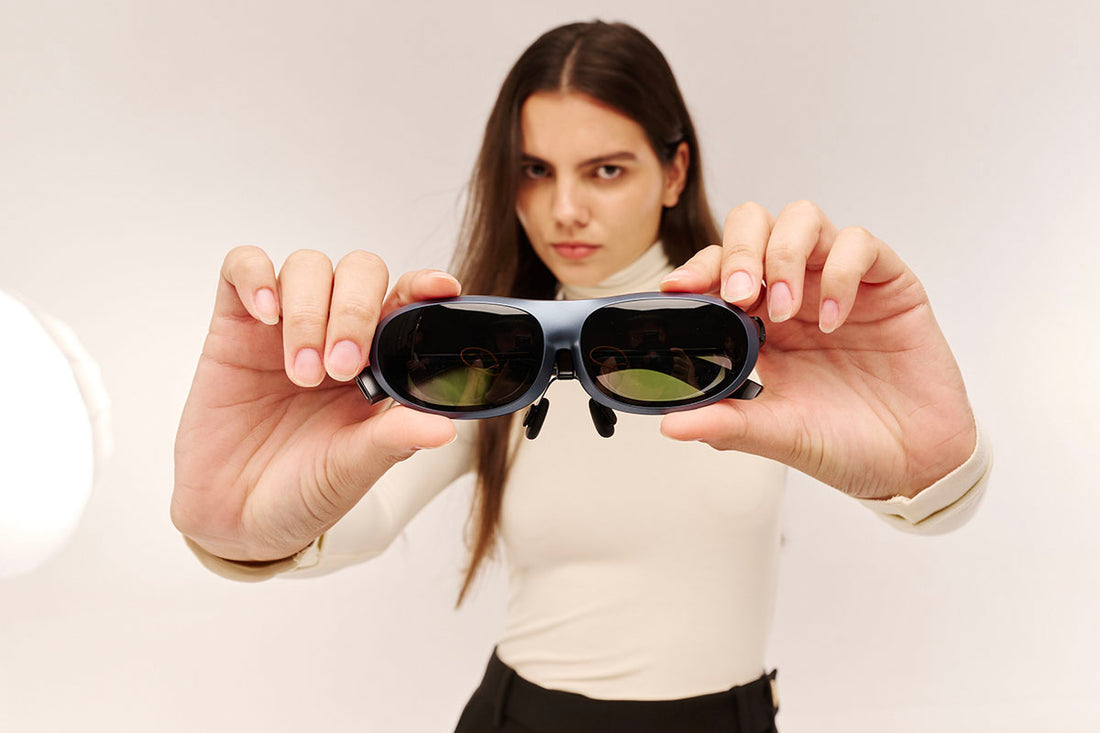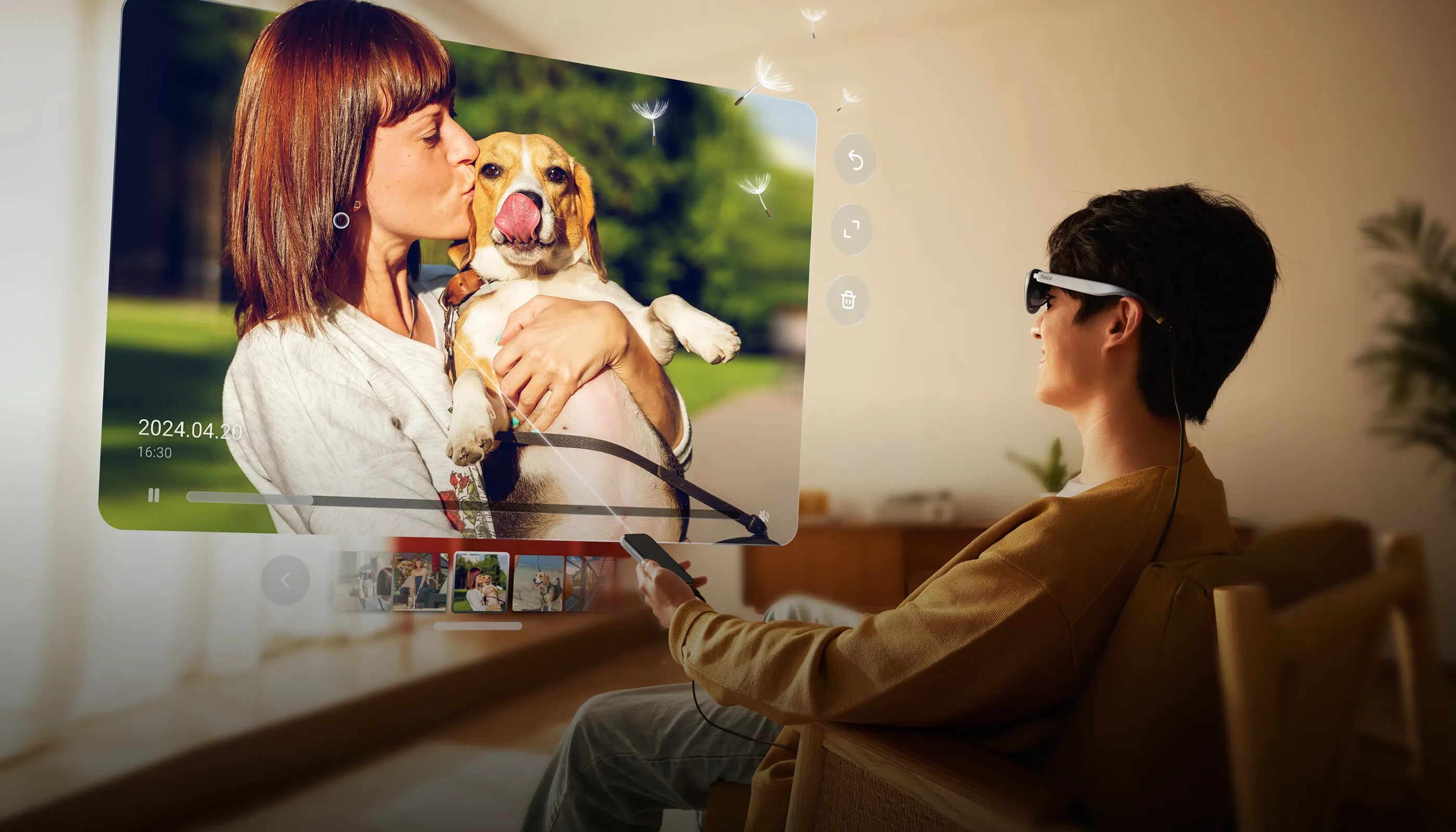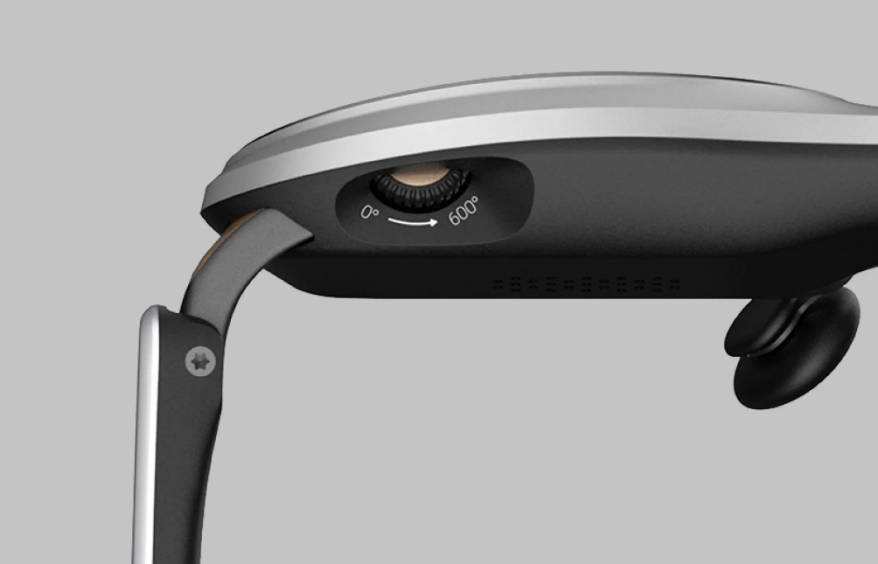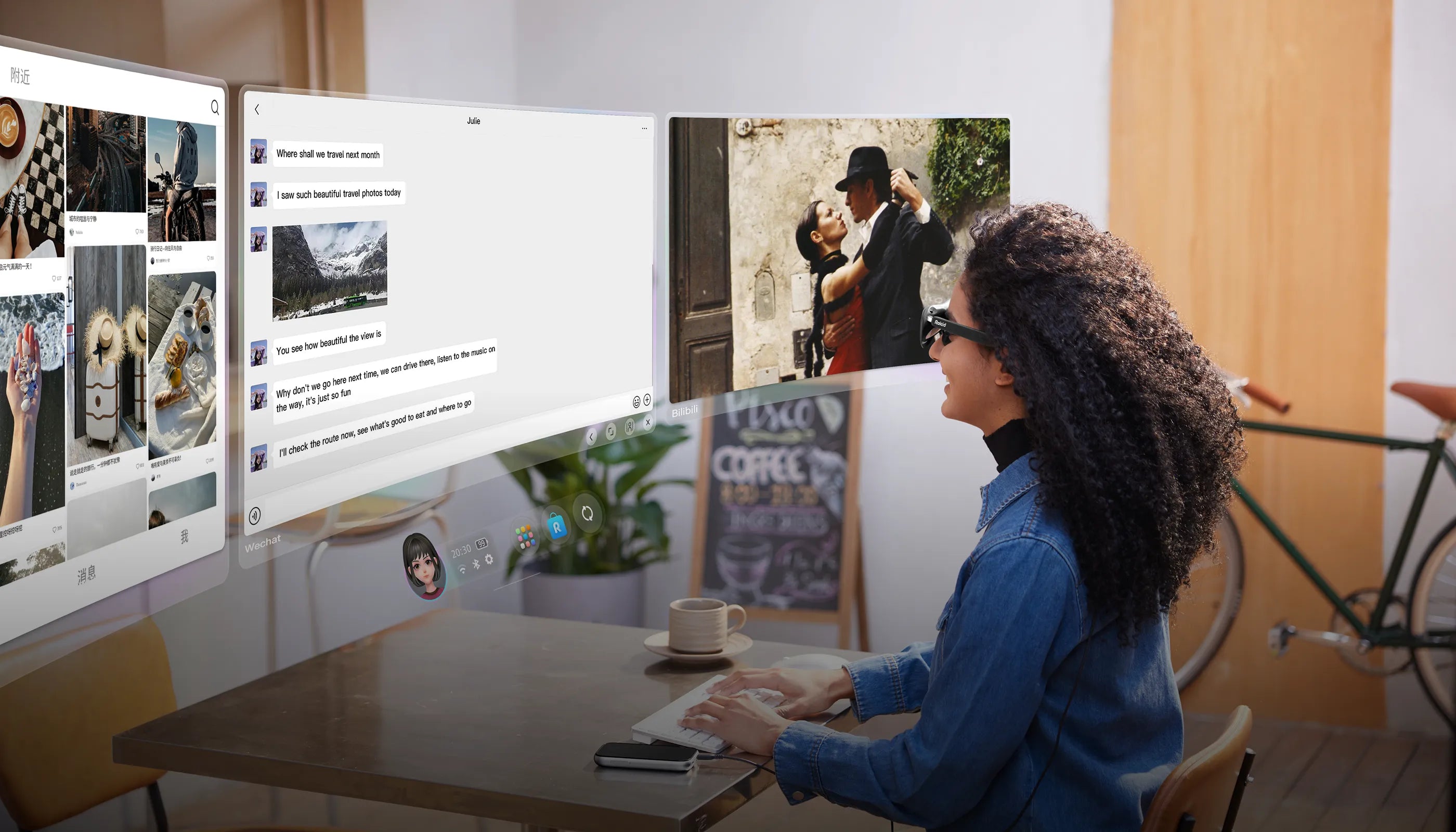
Imagine a world where information seamlessly blends with your reality, where language barriers dissolve, and your glasses become an extension of your mind. This is the future promised by augmented reality (AR) smart glasses, a revolutionary technology poised to transform how we interact with the world around us.
Rokid, a leading innovator in the field, is at the forefront of this exciting development, pushing the boundaries of what's possible with smart glasses display technology. This comprehensive guide delves into the fascinating world of AI smart glasses, exploring their inner workings, diverse applications, and potential impact on various aspects of our lives.
I. Introduction to AI Smart Glasses
Defining AI Smart Glasses:
AI smart glasses are a type of high-tech glasses that integrate artificial intelligence (AI) with AR capabilities. They typically feature a smart glasses display embedded within the lenses, projecting digital information onto your real-world view. AI algorithms analyze data from the environment, user interactions, and other sources to provide contextually relevant information and perform various tasks.
Brief History and Evolution:
The concept of smart glasses has been around for decades, but early models were bulky and limited in functionality. The advent of advanced AI and AR technologies has fueled a recent surge in innovation, with Rokid playing a pivotal role. Their smart glasses display technology, showcased in models like the Rokid Max, exemplifies the potential of this technology, offering features like voice translation, real-time information overlays, and hands-free interaction.
II. How AI Smart Glasses Work
Core Technologies Behind AI Smart Glasses:
- Augmented Reality (AR): AR technology seamlessly blends digital elements with the physical world, creating an interactive overlay. This allows users to see information like directions, translations, or even 3D models superimposed on their surroundings.
- Artificial Intelligence (AI): AI algorithms power the intelligence behind smart glasses. They process data from sensors, cameras, and user interactions to understand the context, recognize objects, and provide relevant information or perform actions.
- Microdisplays: Tiny displays embedded in the lenses project digital information directly onto the user's retinas, creating a natural viewing experience.
- Sensors: Various sensors like cameras, accelerometers, and gyroscopes collect data about the environment and user interactions, providing valuable input for AI algorithms.
User Interface and Interaction:
AI smart glasses offer multiple ways to interact, including:
- Voice commands: Users can speak natural language commands to control the glasses, access information, or perform actions.
- Touchpad or gesture control: Some models feature touchpads on the side of the glasses or allow for gesture control using hand movements.
- Eye tracking: Advanced models can track eye movements, enabling users to select options or interact with elements by simply looking at them.

III. Applications of AI Smart Glasses
The potential applications of AI smart glasses are vast and span across various industries and sectors:
In Healthcare:
- Remote patient monitoring: Doctors can remotely monitor patients' vital signs and health data through the glasses.
- Surgical guidance: Surgeons can access real-time patient information and 3D medical models overlaid onto the surgical field.
- Rehabilitation therapy: Patients can receive visual and audio cues to guide them through rehabilitation exercises.
In Education and Training:
- Interactive learning: Students can access additional information and explanations about their surroundings through AR overlays.
- Remote training: Trainees can receive real-time guidance and feedback from instructors located remotely.
- Language learning: Real-time translation overlays can facilitate communication and language learning in real-world scenarios.

Business and Industry Use Cases:
- Field service and maintenance: Technicians can access manuals, schematics, and real-time data about equipment through AR overlays.
- Warehouse management: Workers can receive visual guidance for picking and packing tasks, improving efficiency and accuracy.
- Remote collaboration: Teams can share information and collaborate on projects using AR annotations and live video feeds.
IV. Benefits of AI Smart Glasses
- Enhanced Accessibility Features: AI smart glasses can provide essential assistance to people with disabilities, such as visually impaired individuals who can receive audio descriptions of their surroundings.
- Productivity and Efficiency Gains: By providing instant access to information and automating tasks, augmented reality AR glasses can significantly improve productivity in various fields.
- Immersive and Engaging Experiences: AR overlays can transform everyday activities, making learning, entertainment, and even shopping more interactive and engaging.
V. Leading Brands and Models
Market Leaders in AI Smart Glasses:
Several companies are developing and producing AI smart glasses, each with its unique strengths and target markets. Here are some notable players:
- Rokid: Renowned for its innovative smart glasses display technology, offering models like the Rokid Max and Rokid Air that cater to both consumers and enterprise users. These glasses boast high-resolution displays, powerful AI processors, and a wide range of features like voice control, translation, and AR overlays.
- Microsoft: Focusing on enterprise applications, Microsoft offers the HoloLens 2, a high-end mixed reality headset known for its advanced holographic capabilities and spatial mapping technology. It's primarily used for industrial training, design visualization, and remote collaboration.
- Google: Google Glass Enterprise Edition 2 targets businesses with a focus on ruggedness and enterprise-specific features like barcode scanning and document viewing. However, its consumer version remains discontinued.
- Envision: Primarily caters to visually impaired individuals, offering glasses like the Envision Glasses that utilize AI to narrate surroundings, recognize objects, and read text aloud, promoting greater independence and accessibility.

Comparison of Popular Models:
| Feature | Rokid Max | Microsoft HoloLens 2 | Google Glass Enterprise Edition 2 | Envision Glasses |
|---|---|---|---|---|
| Display Type | MicroOLED | LCoS | MicroOLED | MicroOLED |
| Field of View (FOV) | 50° | 52° | 32° | 40° |
| Resolution | 1920 x 1080 per eye | 2560 x 1440 per eye | 640 x 360 per eye | 1920 x 1080 per eye |
| Operating System | Android 11 | Windows Holographic | Android 11 | Android 10 |
| Connectivity | Wi-Fi, Bluetooth 5.0 | Wi-Fi, Bluetooth 5.1 | Wi-Fi, Bluetooth 5.2 | Wi-Fi, Bluetooth 5.0 |
| Weight | 75g | 540g | 50g | 170g |
| Battery Life | Up to 4 hours | Up to 3 hours | Up to 3 hours | Up to 4 hours |
| Price | $399 USD | $3,500 USD | $3,500 USD | $3,499 USD |
| Key Features | Voice translation, multi-language subtitles, AR content browser, hands-free interaction | High-resolution holographic displays, gesture control, hand tracking | Enterprise-focused, rugged design, remote management, voice control | Designed for visually impaired users, text-to-speech, object recognition, obstacle avoidance |
VI. Design and Aesthetics
Style Meets Functionality:
AI smart glasses are no longer clunky prototypes. Leading brands like Rokid prioritize both functionality and aesthetics, offering sleek and stylish designs that blend seamlessly with everyday wear. The Rokid Max, for example, boasts a lightweight form factor and comes in various colors to cater to individual preferences.
Customization Options:
Some models offer customization options, allowing users to personalize their experience. This could include interchangeable frames, different lens types, and even custom software features.
VII. AI Smart Glasses in Everyday Life
Consumer Applications:
Beyond specialized fields, AI smart glasses have the potential to revolutionize our daily lives. Imagine:
- Navigating unfamiliar cities with real-time directions and cultural information overlaid on your surroundings.
- Receiving hands-free notifications and messages without needing to pull out your phone.
- Translating languages in real-time, fostering meaningful conversations and breaking down communication barriers.
- Accessing information seamlessly while on the go, such as recipes while cooking or repair manuals while fixing something.
Enhancing Personal Experiences:
AI smart glasses can enrich personal experiences. Imagine:
- Attending concerts or sporting events with live statistics, player information, and behind-the-scenes content displayed directly in your field of view.
- Exploring museums with interactive exhibits and historical information brought to life through AR.
- Learning new skills with personalized, step-by-step instructions overlaid on real-world objects.

VIII. AI Smart Glasses in Specialized Fields
Use in Military and Law Enforcement:
AI smart glasses offer significant advantages in these fields. Soldiers can access tactical information, maps, and communication tools directly in their field of view. Law enforcement officers can leverage facial recognition and real-time data analysis for improved situational awareness and safety.
Innovations in Sports and Entertainment:
Athletes can receive real-time performance data and coaching cues during training and competitions. Spectators can enjoy enhanced viewing experiences with AR overlays displaying statistics, player information, and even instant replays.
IX. Privacy and Ethical Considerations
Data Security Challenges:
AI smart glasses collect and process sensitive data, raising concerns about privacy and security. It's crucial for manufacturers to implement robust security measures and ensure transparent data usage practices.
Ethical Implications and Public Perception:
The widespread adoption of AI smart glasses raises ethical questions about potential misuse, such as facial recognition for surveillance or the manipulation of AR content. Open discussions and clear regulations are necessary to address these concerns and ensure responsible development.
X. Future of AI Smart Glasses
Emerging Trends and Predictions:
- Advancements in miniaturization and battery life will lead to sleeker and more comfortable glasses.
- Improved AR displays will offer wider fields of view and higher resolutions, blurring the lines between the real and virtual worlds.
- AI capabilities will become more sophisticated, enabling more natural and intuitive interactions.
- Integration with other technologies like the Internet of Things (IoT) will unlock new possibilities and applications.
Potential Breakthroughs on the Horizon:
The future of AI smart glasses is brimming with potential breakthroughs. Imagine:
- Brain-computer interfaces that allow direct control of the glasses with your thoughts.
- Haptic feedback integrated into the glasses, creating a more immersive and interactive experience.
- Real-time medical diagnostics and health monitoring through sensors embedded in the glasses.
XI. Integration with Other Technologies
IoT and AI Smart Glasses:
AI smart glasses will seamlessly integrate with the IoT, allowing them to interact with and control various smart devices in your environment. Imagine adjusting your thermostat, turning on lights, or even starting your car, all through voice commands or gestures using your glasses.
Compatibility with Existing Devices:
For widespread adoption, AI smart glasses need to be compatible with existing smartphones, computers, and other devices. This will ensure a smooth user experience and allow users to leverage their existing data and applications.
XII. User Experience and Feedback
Consumer Reviews and Testimonials:
Understanding user experiences is crucial for the development of AI smart glasses. Reading consumer reviews and testimonials can provide valuable insights into user preferences, pain points, and areas for improvement.
User-Friendly Features and Limitations:
AI smart glasses must be user-friendly and intuitive to use. This includes features like voice control, natural language processing, and clear visual interfaces. It's also important to acknowledge and address limitations, such as battery life and potential compatibility issues.
XIII. Challenges and Limitations
Technical Hurdles:
Despite significant advancements, technical challenges remain. These include miniaturization of components, improving battery life, and ensuring seamless integration with existing infrastructure.
Market Adoption Barriers:
Cost, privacy concerns, and lack of compelling use cases are some of the barriers to widespread adoption of AI smart glasses. Addressing these concerns and developing killer applications will be crucial for mainstream success.
XIV. Regulatory Landscape
Industry Standards and Regulations:
Clear industry standards and regulations are necessary to ensure responsible development, data privacy, and user safety. Regulatory bodies are actively working on establishing frameworks for AI smart glasses, addressing issues like data collection, device security, and potential ethical implications.
Impact of Global Policies:
The global landscape of AI smart glasses regulations is evolving rapidly. Different countries and regions have varying policies and approaches, which can create challenges for manufacturers and users alike. Staying informed about evolving regulations and ensuring compliance will be essential for companies operating in this space.
XV. Cost and Affordability
Pricing Analysis:
AI smart glasses are currently a relatively expensive technology, with prices ranging from a few hundred to several thousand dollars. As the technology matures and production scales up, prices are expected to decrease, making them more accessible to a wider audience.
Cost-Benefit Evaluation:
The decision to purchase AI smart glasses depends on individual needs and budgets. Carefully evaluate the potential benefits of this technology for your specific use case and weigh them against the current cost. Consider factors like improved productivity, enhanced accessibility, or enriched personal experiences to make an informed decision.
XVI. AI Smart Glasses: Deep Dive
Features of Rokid Smart Glasses:
As a leading innovator in the field, Rokid offers a range of AI smart glasses packed with advanced features, including:
- High-resolution microdisplays: Delivering a crisp and clear viewing experience.
- Powerful AI processors: Enabling real-time data processing and advanced functionalities.
- Voice control and gesture recognition: For intuitive and hands-free interaction.
- Multi-language translation: Breaking down communication barriers in real-time.
- AR overlays and information visualization: Enhancing your surroundings with valuable information.
- Open app ecosystem: Allowing developers to create innovative applications for various needs.
Real-World Impact and Case Studies:
AI smart glasses are already making a positive impact in various industries and sectors. Here are some real-world examples:
- Healthcare professionals: Using them for remote patient monitoring, surgical guidance, and rehabilitation therapy.
- Manufacturing workers: Receiving real-time instructions and data visualizations for improved efficiency and accuracy.
- Field service technicians: Accessing manuals, schematics, and real-time data to troubleshoot issues faster.
- Tourists and travelers: Enjoying enhanced sightseeing experiences with translated information and cultural insights.

XVII. FAQs About AI Smart Glasses
Common Questions and Expert Answers:
Here are some frequently asked questions about AI smart glasses, answered by experts in the field:
-
What are the privacy concerns associated with AI smart glasses?
- Experts emphasize the importance of robust data security measures and transparent data usage practices. Users should have control over their data and be able to opt out of data collection when desired.
-
How will AI smart glasses impact our daily lives?
- Experts believe they have the potential to revolutionize various aspects of our lives, from communication and learning to entertainment and work. The impact will depend on how responsibly and ethically this technology is developed and used.
-
What are the limitations of AI smart glasses currently?
- Experts acknowledge limitations like battery life, cost, and the need for more compelling use cases. Continuous development and innovation are addressing these limitations to pave the way for wider adoption.
XVIII. Conclusion and Future Outlook
Summarizing Key Takeaways:
AI smart glasses represent a transformative technology with the potential to reshape the way we interact with the world around us. From enhancing accessibility and boosting productivity to creating immersive experiences and fostering communication, the possibilities are vast.
The Road Ahead for AI Smart Glasses:
The future of AI smart glasses is bright. As technology advances, costs decrease, and regulations adapt, we can expect:
- Sleeker and more comfortable designs.
- More powerful AI capabilities and intuitive interfaces.
- Wider adoption across various industries and daily life.
- Integration with other technologies like the IoT, unlocking even more possibilities.
While challenges remain, the potential benefits of AI smart glasses are undeniable. By embracing responsible development, addressing ethical concerns, and focusing on user needs, this technology can truly revolutionize the way we see and experience the world.
I hope this comprehensive blog post provides valuable insights into the exciting world of AI smart glasses. Stay tuned for further developments in this rapidly evolving field!



